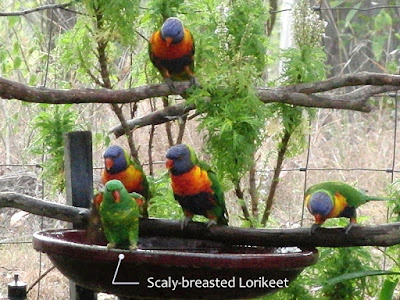I love birds. I wanted
them to come to my yard, so I placed two water basins several years ago, one in the front yard
and the other one in the backyard. I live in Queensland, Australia, the weather
here is very hot in summer and birds get thirsty easily. Birds are coming
constantly to the water basins, some take a bath and some drink water.
One of the common birds around here is the Rainbow Lorikeet, a bird that is
colourful and active. They usually go around in pairs; a pair has a close
relationship and is lovely. Foreigners who visit Australia for the very first
time would be surprised to see its colour.
Here are some pictures of Rainbow
lorikeets below.
Well, are you surprised?
When I saw them for the first time, I thought what a daring design they are!
Who designed them?
When I was a kid, I learnt that most animals which are targeted by a predator have protective coloration. Following the previous theory of protective coloration, I cannot understand the color scheme of the Rainbow Lorikeet. Look at their colour; orange, yellow, blue, red, green. These are the kind of colours almost the same as the crayon which the child in kindergarten uses. Why is this colour scheme needed?
When I was a kid, I learnt that most animals which are targeted by a predator have protective coloration. Following the previous theory of protective coloration, I cannot understand the color scheme of the Rainbow Lorikeet. Look at their colour; orange, yellow, blue, red, green. These are the kind of colours almost the same as the crayon which the child in kindergarten uses. Why is this colour scheme needed?
Countershading is one of wild animals' features. For example, penguins have a white colour in front and black on their back. They spend lots of time in the ocean, and when a predator comes under them and looks at them above, their white stomach melts into a bright sky colour and it becomes hard to be found. It's not every animal but lots of animals, especially birds and fish have a lighter coloured stomach.
From this way of thinking, rainbow lorikeets should have a bright colored stomach, but they don't. On the contrary, they have very colourful stomachs; orange, yellow and blue that is close to purple. I wondered if they don't have a chance to be pursued by a predator?
There are several tall trees in my yard and they love these trees. One day, I heard they were chirping on the front yard trees. I looked up and tried to see them, but I couldn't see them. I'm nearsighted, so I used my camera and zoomed the lens, but still I couldn't find them. I was amazed that I couldn't find the birds with their vivid colours. The predators around here are raptors. If they saw rainbow lorikeets from the sky, can they see these colourful birds on a tree?
Then one idea came up in my mind, in my impression, animals in tropical areas have vivid colours on their body. I wondered if their body colour was related to the strength of the sunlight?
If I have a chance to see an ornithologist, I
would like to ask why the Rainbow Lorikeet is colourful.
Mother nature is a daring designer, isn't she?




No comments:
Post a Comment